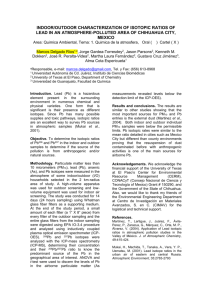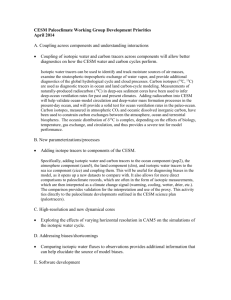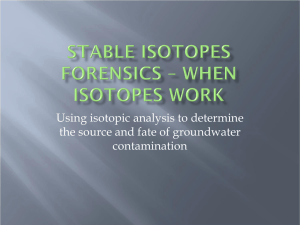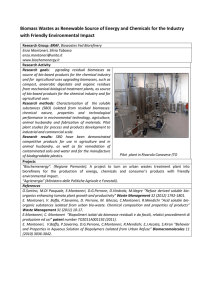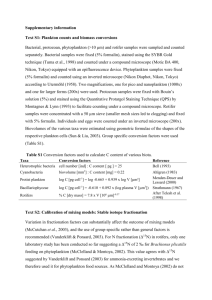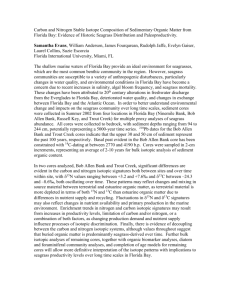fec12444-sup-0003-TableS2
advertisement
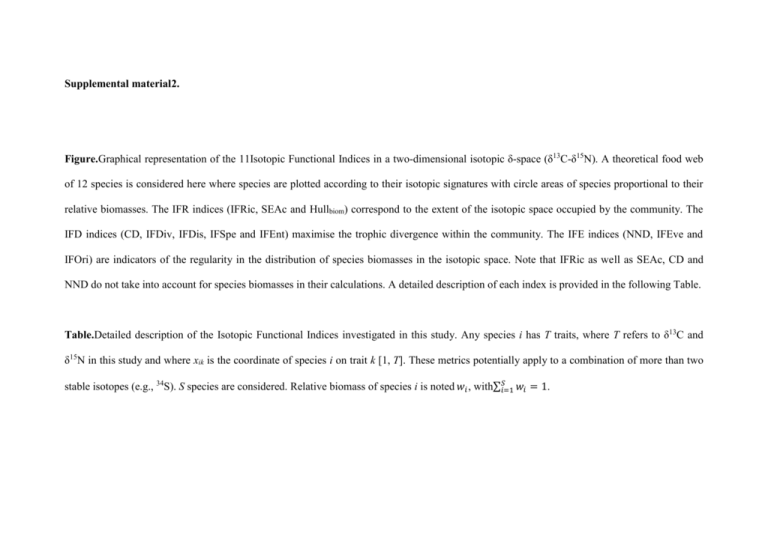
Supplemental material2. Figure.Graphical representation of the 11Isotopic Functional Indices in a two-dimensional isotopic δ-space (δ13C-δ15N). A theoretical food web of 12 species is considered here where species are plotted according to their isotopic signatures with circle areas of species proportional to their relative biomasses. The IFR indices (IFRic, SEAc and Hullbiom) correspond to the extent of the isotopic space occupied by the community. The IFD indices (CD, IFDiv, IFDis, IFSpe and IFEnt) maximise the trophic divergence within the community. The IFE indices (NND, IFEve and IFOri) are indicators of the regularity in the distribution of species biomasses in the isotopic space. Note that IFRic as well as SEAc, CD and NND do not take into account for species biomasses in their calculations. A detailed description of each index is provided in the following Table. Table.Detailed description of the Isotopic Functional Indices investigated in this study. Any species i has T traits, where T refers to δ13C and δ15N in this study and where xik is the coordinate of species i on trait k [1, T]. These metrics potentially apply to a combination of more than two stable isotopes (e.g., 34S). S species are considered. Relative biomass of species i is noted 𝑤𝑖 , with∑𝑆𝑖=1 𝑤𝑖 = 1. Species Index Index General name code description Details of calculation and references biomass ? The convex hull volume is computed with the Quickhull algorithm described by Barber, Dobkin & Huhdanpaa Convex Hull (1996). It first determines the most extreme isotopic values of the community (vertices), links them to build the Isotopic Volume (minimum Functional volume convex hull and finally calculates the volume encompassed by vertices (Cornwell, Schwilk & Ackerly 2006). IFRic is standardized by the ‘global’ IFRic that includes all species (of the two communities investigated) so that IFRic Richness encompassed by species the No its values are constrained between 0 and 1.This index corresponds to the Total Area index (also called Convex in Hull Area) in Layman et al. (2007) and is similar to the Functional Richness index (FRic) described in Villéger, Isotopic functional Richness isotopic space) Mason & Mouillot (2008), but in a -space. A measure of the Corrected Standard SEAc Ellipse Area mean core niche Calculated from the variance and covariance of the δ13C and δ15N data (Jackson et al., 2011). In this study, SEAc area of the is standardized by the ‘global’ SEAc that corresponds to the sum of the SEAc of the two communities community isotopic No investigated, and therefore SEAc values are constrained between 0 and 1. niche This index is a hybrid metric that corresponds to the amount of the space occupied by the community adjusted Hull biom Convex Hull by species relative biomasses (Clark et al., 2012), but in a δ-space.The convex hull is calculated on vertex Volume weighted species only.To calculate this metric, isotopic values are first standardized to a mean of zero and a standard species deviation of one (values between 0 and 1). Isotopic data of vertex species are then weighted by individual Hull biom Yes by biomasses species relative biomass prior to calculating the Convex Hull Volume/Area. This weighting procedure moves rare species further towards the centre of gravity of the distribution of the isotopic values and therefore de- emphases their influence on isotopic diversity while leaving very abundant species comparatively unchanged (preserving their influence on isotopic diversity) (Clark et al., 2012). Corresponds to the average Euclidean distance of species isotopic signatures to the δ13C and δ15N centroid (Layman et al., 2007), where the centroid (gk) corresponds to the mean δ13C and δ15N value for all species in the community. CD is expressed as a percentage of the maximal distance observed in the community and therefore ranges from 0 to 1. 𝐶𝐷 = Mean Distance of Distance to Isotopic functional Divergence species to Centroid Centroid CD ∑𝑆𝑖=1 𝑑𝐺𝑖 𝑆 where 𝑑𝐺𝑖 corresponds to the Euclidean distance from a species ito the centre of gravity gk No (CD) 𝑇 𝑑𝐺𝑖 = √ ∑(𝑥𝑖𝑘 − 𝑔𝑘 )2 𝑘=1 Where 𝑔𝑘 = ∑ 𝑥𝑖𝑘 𝑆 CD is equivalent to IFSpe (described below), where the distance to centroid is called the centre of gravity while refering to the same calculation (mean of all δ13C and δ15N isotopic values) Species deviance This index first determines the centre of gravity (Gk) of the convex hull on the basis of the vertex species of the Isotopic from the Functional IFDiv ̅̅̅̅ ) of species to the centre of gravity. community. It then computes the average biomass-weighted distance (𝑑𝐺 mean distance to the Divergence Note that the position of the centre of gravity is not weighted by specific biomasses and is determined only from centre of gravity the most extreme isotopic values (vertices) of the community. This index ranges from 0 to 1. weighted by relative Yes biomass 𝐼𝐹𝐷𝑖𝑣 = ∆𝑑 + ̅̅̅̅ 𝑑𝐺 ∆|𝑑| + ̅̅̅̅ 𝑑𝐺 ̅̅̅̅ ), Where ∆𝑑 = ∑𝑆𝑖=1 𝑤𝑖 (𝑑𝐺𝑖 − 𝑑𝐺 and ∆|𝑑| = ∑𝑆𝑖=1 𝑤𝑖 |𝑑𝐺𝑖 − ̅̅̅̅ 𝑑𝐺 | where 𝑑𝐺𝑖 is the Euclidean distance between the species i and the centre of gravity 𝐺𝑘 of the convex hull 1 (coordinates of the centre of gravity 𝐺𝑘 = ∑𝑉𝑖=1 𝑥𝑖𝑘 of the V species forming the vertices of the convex Hull) 𝑉 ̅̅̅̅ is the mean distance of the S species to the centre of gravity 𝐺𝑘 and 𝑑𝐺 IFDiv is similar to Functional Divergence index (FDiv) defined in Villéger et al. (2008), but applied in a δ-space IFDis accounts for relative biomasses by shifting the position of the centre of gravity towards the most biomass- Isotopic Functional IFDis Dispersion FDis is the weighted dominant species (Laliberté & Legendre, 2010). It then computes a weighted average distance to this weighted mean distance of centre of gravity, using again the relative biomasses as weights. Contrary to IFDiv, both the centre of gravity and species the average distance to this centre are weighted by individual biomasses. IFDis is expressed as a percentage of to the the maximal distance to the centre of gravity observed in the species pool (ranges from 0 to 1). community weighted centre of gravity c of 𝐼𝐹𝐷𝑖𝑠 = Yes ∑ 𝑤𝑖 (𝑥𝑖𝑘 − 𝑐) ∑ 𝑤𝑖 all IFDis is the weighted mean distance to the weighted centre of gravity c species 𝒄= ∑ 𝑤𝑖 × 𝑥𝑖𝑘 ∑ 𝑤𝑖 Average biomass- This index is close to the IFDiv but slightly differs in the computation as it calculates distances from a weighted distance hypothetical mean species (i.e. average value of isotopic signatures exhibited by all species of the community) of all species to a rather than to the centre of gravity of the vertex species (Bellwood et al., 2006). IFSpe does not account for hypothetical relative biomass of species in the establishment of the hypothetical mean species. It uses however the relative Isotopic Functional IFSpe Yes Specialization mean 𝑔𝑘 species (or centre of gravity) biomasses of species as weight to compute a weighted average distance to the hypothetical mean species. IFSpe is expressed as a percentage of the maximal specialization observed in the community and therefore ranges from 0 to 1. 𝑆 𝐼𝐹𝑆𝑝𝑒 = ∑(𝑤𝑖 × 𝑑𝐺𝑖 ) 𝑖=1 Where 𝑑𝐺𝑖 corresponds to the Euclidean distance from a species ito the centre of gravity gk : 𝑇 𝑑𝐺𝑖 = √ ∑(𝑥𝑖𝑘 − 𝑔𝑘 )2 𝑘=1 𝑔𝑘 = ∑ 𝑥𝑖𝑘 𝑆 IFSpe is equivalent to CD but integrates biomass. Sum of pairwise It is the sum of pairwise distances between species in the isotopic space weighted by species relative biomasses. 𝑆 distances Isotopic Rao’s 𝑆 ∑ ∑ 𝑑𝑖𝑗 × 𝑤𝑖 × 𝑤𝑗 between species in 𝑖=1 𝑗=1 quadratic IFEnt the isotopic space Where 𝑑𝑖𝑗 is the Euclidean distance between ith and jhspecies weighted The quadratic entropy index (Rao, 1982) can be viewed as a multivariate measure of the functional divergence by species relative (Mason et al., 2005; Schleuter et al., 2010) and is conceptually similar and highly correlated to IFDis (Laliberté biomasses & Legendre, 2010; Clark et al., 2012). entropy Q Yes It measures how evenly species are spaced to their nearest neighbour in the isotopic space. Whilst NND provides an average measure of nearest neighbour distance, this can also provide a proxy of evenness for these distances Nearest Neighbor NND Mean distance of when expressed as a % of maximal distancein the isotopic space, and therefore ranges from 0 to 1. NND each species to its considers only species occurrence (presence/absence data only) and does not account for species’ biomasses nearest neighbour in (Layman et al., 2007). No the δ13C - δ15N bi- Distance 𝑁𝑁𝐷 = plot space ∑ 𝑑𝑖𝑗 𝑆 Where 𝑑𝑖𝑗 is the Euclidean distance between species i and its nearest neighbor j Isotopic functional Evenness Apart from giving the same weight to all species, NND is equivalent to IFOri (described below). It is a proxy of the regularity in biomass distribution in the -space. It is based on the minimum spanning tree which links all the species in the isotopic space with the minimum of branch lengths. This index takes into account both the regularity of space between species and the evenness in the distribution of species biomasses. It Evenness of ranges from 0 to 1 (1 = species regularly distributed), indicating a level of fullness of the -space by biomasses Isotopic (Villéger et al. 2008). biomasses Functional IFEve distribution in the Yes Evenness minimum spanning ∑𝑆−1 min [ 𝑙 𝐹𝐸𝑣𝑒 = tree dist(i,j)/(wi +wj ) 1 1 , ]− ∑S−1 𝑆−1 l=1 dist(i,j)/(wi +wj ) 𝑆−1 1 1− 𝑆−1 Where dist(i,j) is the Euclidean distance between species i and j, the species involved in branch l of the MST (minimum spanning tree) IFEve is close to the Functional Evenness index in a biological trait functional space (FEve) Isotopic IFOri Mean biomass- It measures how evenly species are spaced to their nearest neighbor in the isotopic space. The IFOri is based on the Euclidean distance to the nearest neighbor weighted by the relative biomass of species. This index takes into Yes Functional weighted distance Originality of species to their account the regularity of space between nearest neighbor species and the evenness in the distribution of biomasses of species. IFOri is expressed as a percentage of the maximal originality observed in the species pool which corresponds to an optimal even distribution of species in the isotopic space (i.e. optimal functional nearest neighbor regularity). The index is 1 if all distances between nearest neighbor species correspond to the optimal distribution with all species having the same biomasses (Mouillot et al., 2013). 𝐼𝐹𝑂𝑟𝑖 = ∑𝑆𝑖=1 𝑑𝑖𝑗 × 𝑤𝑖 𝑆 Where 𝑑𝑖𝑗 is the Euclidean distance between species i and its nearest neighbor j IFOri is the “biomass-weighted” equivalent of NND. References Barber, C.B., Dobkin, D.P. &Huhdanpaa, H. (1996) The Quickhull algorithm for convex hulls. ACM Transactions on Mathematical Software,22, 469-483. Bellwood, D., Wainwright, P., Fulton, C.&Hoey, A.(2006) Functional versatility supports coral reef biodiversity. Proceedings of the Royal Society B: Biological Sciences,273, 101-107. Clark, C.M., Flynn, D.F.B., Butterfield, B.J.& Reich, P.B.(2012)Testing the link between functional diversity and ecosystem functioning in a Minnesota grassland experiment. PLoS ONE,7, e52821. Cornwell, W.K., Schwilk, D.W.&Ackerly, D.D.(2006)A trait-based test for habitat filtering: Convex hull volume. Ecology,87, 1465-1471. Jackson, A.L., Inger, R., Parnell, A.C.&Bearhop, S.(2011) Comparing isotopic niche widths among and within communities: SIBER - Stable Isotope Bayesian Ellipses in R. Journal of animal ecology, 80, 595-602. Laliberté, E.& Legendre, P.(2010) A distance-based framework for measuring functional diversity from multiple traits.Ecology,91, 299-305. Layman, C.A., Arrington, D.A., Montana, C.G.& Post, D.M.(2007) Can stable isotope ratios provide for community-wide measures of trophic structure? Ecology,88, 42-48. Mason, N.W.H., Mouillot, D., Lee, W.G.& Wilson, J.B. (2005) Functional richness, functional evenness and functional divergence: the primary components of functional diversity. Oikos,111, 112-118. Mouillot, D., Graham, N.A.J., Villéger, S., Mason, N.W.H.& Bellwood, D.R.(2013)A functional approach reveals community responses to disturbances. Trends in Ecology & Evolution,28, 167-177. Rao, C.R.(1982) Diversity and dissimilarity coefficients: a unified approach. Theoretical Population Biology,21, 24-43. Schleuter, D., Daufresne, M., Massol, F.&Argillier, C.(2010) A user’s guide to functional diversity indices.Ecological Monographs,80, 469-484. Villéger, S., Mason, N.W.H.&Mouillot, D. (2008) New multidimensional functional diversity indices for a multifaceted framework in functional ecology.Ecology,89, 2290-2301.

